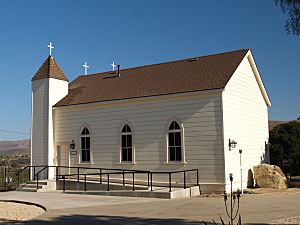Chapel of San Ramon facts for kids
Quick facts for kids Chapel of San Ramon |
|
|---|---|
 |
|
| Location | 6601 Foxen Canyon Rd, Santa Maria, CA |
| Built | 1875 |
| Official name: Chapel of San Ramon | |
| Designated | January 13, 1975 |
| Reference no. | 877 |
The Chapel of San Ramon is a special building with a cemetery in Santa Maria, California, United States. It's also known as the Benjamin Foxen Memorial Chapel or the Sisquoc Chapel. This chapel is recognized as a California Historical Landmark. It was also the very first historic landmark listed by Santa Barbara County, California.
This church is a great example of how buildings changed from the old Spanish missions to the wooden churches built by American settlers. It was one of the first Catholic churches in the Santa Maria Valley. The chapel was built way back in 1875.
History of the Chapel
In 1872, Frederick and Ramona Foxen Wickenden bought the land where the chapel now stands. They generously gave some of their land for the chapel and a cemetery. Frederick Wickenden sold 5,000 sheep to buy special redwood wood for building the chapel. He, his brother-in-law Thomas Foxen, and Chris Clausen built it in 1875.
Father J.B. McNally, a priest from Santa Ynez, designed the church. The first person buried in the cemetery was Benjamin Foxen in 1876. He was Ramona Wickenden's father and Thomas Foxen's brother. In 1879, the chapel was officially dedicated by Francisco Mora y Borrell. It was named after Saint Ramon.
In 1908, the chapel became part of the Parish of Saint Mary. Regular church services stopped that year. The chapel was then used only for special events. In 1936, the chapel got a new roof and a fresh coat of paint. R.E. Easton helped rededicate the building.
In 1950, a group called the Native Daughters of the Golden West declared the chapel their own historic landmark. They called it the "Benjamin Foxen Memorial Chapel." From 1958 to 1959, Winston Wickenden renovated the chapel. He replaced the original wooden foundation with strong concrete. In 1966, it became the first historic landmark recognized by Santa Barbara County.
Modern Times at the Chapel
Over time, the chapel started to have problems with vandalism and structural issues. In 1972, a group called the San Ramon Preservation group was formed. Their goal was to help protect the property from more damage. In January 1975, the chapel was officially added to the California Historical Landmarks list.
A special dedication ceremony was held in August of that year. A Mass was led by Father Bertin Foxen, who was Benjamin Foxen's great-grandson. In December 1975, a gate was put at the entrance to the grounds. It was dedicated as the John W. Woolsey Memorial Gate.
The San Ramon Chapel Preservation Committee (SRCPC) became a non-profit organization in 1976. This group takes care of the property and the building. Weekly Mass services started again in November of that year. In 1978, the chapel received a new roof and new glass windows.
A new foundation was installed in 1983. Other renovations also took place, costing over $12,000. In 1985, the chapel got its first electric heater. Stations of the Cross were installed on the site by Drew Crosby in 1986. The next year, the SRCPC offered to give the property to the Roman Catholic Archdiocese of Los Angeles. However, they declined the offer, so the SRCPC continued to maintain the chapel. The first water well was installed in 1988. Renovations to the chapel continued as of 1999.
More to Explore

